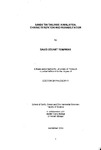SANDY TIN TAILINGS IN MALAYSIA: CHARACTERIZATION AND REHABILITATION
| dc.contributor.author | TOMPKINS, DAVID STUART | |
| dc.contributor.other | Faculty of Science and Engineering | en_US |
| dc.date.accessioned | 2013-10-23T10:02:10Z | |
| dc.date.available | 2013-10-23T10:02:10Z | |
| dc.date.issued | 2003 | |
| dc.identifier | NOT AVAILABLE | en_US |
| dc.identifier.uri | http://hdl.handle.net/10026.1/2309 | |
| dc.description.abstract |
Cassiterite extraction in West Malaysia has left a legacy of some 80,000 hectares of nutrient-poor, drought-prone, quartz sandy tailings. Their proximity to urban centres has long made them a target for agricultural and forestry enterprises, and various techniques have been developed to overcome their intractability, including amendment with bulky organic matter and replacement with natural soils. Although reasonably successful, these approaches have often failed to acknowledge that a percentage of the original heavy mineral suite remains in sandy tailings, exerting possible phytotoxic effects and certainly raising concerns about the suitability of sandy tailings for agronomic crop production. To determine the nature and extent of trace element contamination of sandy tailings, ten different areas were identified and sampled in the states of Selangor and Perak. Preliminary analyses failed to corroborate earlier discoveries of elevated mercury and cadmium status, but lead, zinc, arsenic, uranium and rare earth elements were all common. However, greater concentrations of all these elements were found in clay (slime) tailings, which had been colonized by dense vegetation cover. This indicated that levels of trace elements in sandy tailings were not of themselves phytotoxic, but in the context of reduced nutrient availability, might exert a disproportionate influence on their colonization by plants. The colonization of sandy tailings by Melastoma malabathricum was therefore examined, revealing that in two of four sites, water contents were greater in colonized areas than the rest of each site. Macronutrient concentrations were also greater in colonized tailings, as were concentrations of zinc and manganese, but whether these were the cause or result of plant establishment could not be determined conclusively. Overall, trace element distribution in sandy tailings did not influence colonization by Melastoma, although in three of four populations, foliar concentrations of uranium were greater than those of a population growing on a natural soil. This has serious implications for the agronomic use of sandy tailings. The effects of bulky organic and clay amendment of sandy tailings on the availability and uptake of trace elements has never before been examined. A tropical greenhouse experiment was undertaken to examine the effects of peat and clay on the growth and trace element chemistry of Panicum miliaceum and Pueraria phaseoloides. The use of symbiotic mycorrhizal fungi was also included, since although these often improve the phosphorus nutrition of their hosts, they might also increase trace element uptake from pools sorbed by organic matter. Neither clay nor peat improved the growth of either plant species. However, addition of clay substantially increased the availability of aluminium and trace elements, and its use in rehabilitation attempts cannot be recommended. In contrast, peat reduced the availability of Co, Cu, As, La, Ce and U, whilst simultaneously improving the ECEC of sandy tailings. The effects of mycorrhizal inoculation were difficult to interpret, since the carrier medium used (predominantly zeolite) drastically altered the chemistry of soils to which it was added. Growth of Panicum and Pueraria was equally poor on two of three naturally sandy soils. Adding peat to sandy tailings produced plants with similar foliar chemistry to those grown on natural soils, suggesting that plant communities established on these natural siliceous media could act as models for the sustainable rehabilitation of anthropic mine tailings - something which has never before been suggested. A range of native species are recommended as having potential for further research into naturalistic rehabilitation. | en_US |
| dc.description.sponsorship | lnstitut Sains Biologi, Universiti Malaya | en_US |
| dc.language.iso | en | en_US |
| dc.publisher | University of Plymouth | en_US |
| dc.title | SANDY TIN TAILINGS IN MALAYSIA: CHARACTERIZATION AND REHABILITATION | en_US |
| dc.type | Thesis | |
| dc.identifier.doi | http://dx.doi.org/10.24382/4043 |
Files in this item
This item appears in the following Collection(s)
-
01 Research Theses Main Collection
Research Theses Main


